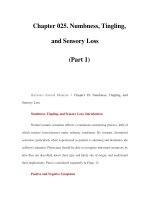Eyesight Associates of Middle - part 1 ppsx
Bạn đang xem bản rút gọn của tài liệu. Xem và tải ngay bản đầy đủ của tài liệu tại đây (319.1 KB, 16 trang )
Janice K. Ledford, COMT
EyeWrite Productions
Franklin, NC
Valerie N. Sanders, CRA, COT
Eyesight Associates of Middle Georgia
Warner Robins, Ga
Series Editors:
Janice K. Ledford • Ken Daniels • Robert Campbell
Copyright © 2006 by SLACK Incorporated
ISBN-10: 1-55642-747-6
ISBN-13: 978-1-55642-747-3
All rights reserved. No part of this book may be reproduced, stored in a retrieval system or transmitted
in any form or by any means, electronic, mechanical, photocopying, recording or otherwise, without writ-
ten permission from the publisher, except for brief quotations embodied in critical articles and reviews.
The procedures and practices described in this book should be implemented in a manner consistent with
the professional standards set for the circumstances that apply in each specific situation. Every effort has
been made to confirm the accuracy of the information presented and to correctly relate generally accepted
practices. The author, editor, and publisher cannot accept responsibility for errors or exclusions or for the
outcome of the application of the material presented herein. There is no expressed or implied warranty of
this book or information imparted by it.
Care has been taken to ensure that drug selection and dosages are in accordance with currently accept-
ed/recommended practice. Due to continuing research, changes in government policy and regulations, and
various effects of drug reactions and interactions, it is recommended that the reader carefully review all
materials and literature provided for each drug, especially those that are new or not frequently used.
The work SLACK Incorporated publishes is peer reviewed. Prior to publication, recognized leaders in
the field, educators, and clinicians provide important feedback on the concepts and content that we publish.
We welcome feedback on this work.
Printed in the United States of America.
Library of Congress Cataloging-in-Publication Data
Ledford, Janice K.
The slit lamp primer / Janice K. Ledford, Valerie N. Sanders.
2nd ed.
p. ; cm. (The basic bookshelf for eyecare professionals)
Includes bibliographical references and index.
ISBN-13: 978-1-55642-747-3 (alk. paper)
ISBN-10: 1-55642-747-6 (alk. paper)
1. Ocular biomicroscopy. I. Sanders, Valerie N.
II. Title. III. Series.
[DNLM: 1. Eye. 2. Microscopy methods. 3. Ophthalmology
instrumentation. WW 143 L473s 2006]
RE79.B5L43 2006
617.7'0028 dc22
2005021279
Published by: SLACK Incorporated
6900 Grove Road
Thorofare, NJ 08086 USA
Telephone: 856-848-1000
Fax: 856-853-5991
www.slackbooks.com
Contact SLACK Incorporated for more information about other books in this field or about the avail-
ability of our books from distributors outside the United States.
For permission to reprint material in another publication, contact SLACK Incorporated. Authorization
to photocopy items for internal, personal, or academic use is granted by SLACK Incorporated provided that
the appropriate fee is paid directly to Copyright Clearance Center. Prior to photocopying items, please con-
tact the Copyright Clearance Center at 222 Rosewood Drive, Danvers, MA 01923 USA; phone: 978-750-8400;
Web site: www.copyright.com; email:
Last digit is print number: 10 9 8 7 6 5 4 3 2 1
Dedications, Second Edition
For the grands: Kathryn Hope and Aaron James.
Jan Ledford
To the many technicians and assistants who have allowed me to be useful in their training.
Val Sanders
Dedications, First Edition
For my part, I would like to dedicate this work to some special teachers who whet my curios-
ity for scientific things: Beatrice Harris (who taught me the scientific method), George M. Hood
(who showed me the rings around Saturn via telescope), Linda Bennett (who introduced me to
the microscopic world of the paramecium), Robert Sipe (who let me use class time to work on a
science project that made it to state competition), Carole Calvert Vann (who made botany and
ecology incredibly interesting), and Sally Blackwell (who let me grow nearly a hundred green
bean plants in her classroom).
Jan Ledford
I would like to dedicate my portion of this endeavor to my family: to my husband, Chuck,
whose unending support could never be matched; to my children, Riley, Zachary, and Carlye,
who have taught me what is important in life; and to my parents, John and Juanita Nordin, who
encouraged me to pursue my goals.
Val Sanders
Contents
Dedications iii
Acknowledgments viii
About the Authors ix
The Study Icons xi
Chapter 1. The Slit Lamp 1
Chapter 2. The Basic Slit Lamp Exam 11
Chapter 3. A Magnified Tour of the Normal Eye 33
Chapter 4. Illumination Techniques 45
Chapter 5. Slit Lamp Findings 57
Chapter 6. The Problematic Examination 85
Chapter 7. The Postoperative Eye 103
Chapter 8. History Mystery 117
Chapter 9. Contact Lens Evaluation for Nonfitters 123
References 135
Index 139
Acknowledgments
We would like to gratefully acknowledge the kind help of so many wonderful people. First,
we appreciate the editorial advice given by Bob Campbell, MD; Ken Daniels, OD; and Jeff Fre-
und, COMT. Dori Witten and Pete Leadman, of Topcon, assisted by providing photographs of
Topcon slit lamps as well as the user’s manuals. We acknowledge the use of certain photographs
from books in SLACK’s original Ophthalmic Technical Skills Series. Collin Ledford was a will-
ing photographic model, as were Susan Dumont, Riley and Zachary Sanders, Karen Brown,
Tammy Langley, and John Nordin. We also thank those providers and technical staff at Eyesight
Associates of Middle Georgia who referred appropriate patients for photography: David Grogan,
PA-C; Matt Dixon, OD; Louis Schlesinger, OD; and Monte Murphy, OD. Others who assisted in
photograph and illustration procurement are Patrick Caroline, COT, FCLSA; Jane Beeman, COA,
FCLSA (of Bausch & Lomb/Polymer Technology); Tim Koch, FCLSA; Sheila Nemeth, COMT;
and J. Michael Coppinger, MA, CRA. Denise Cunningham, COA, COPRA, had the idea for the
illumination mnemonic, although we later developed our own. Jim Ledford, PA-C; Charles
Shaller, MD; and Johnny Gayton, MD graciously loaned us reference materials. ILAMO (Inter-
national Library, Archives, and Museum of Optometry); Joseph T. Barr, OD; and Marcia Meyer
(FDA) helped find references, as well. We are indebted to the following people, who provided
technical advice: Tammy Langley, COT; Todd Hostetter, COMT; Ken Woodworth, COMT;
Donna Knight, COT, CRA; Susan Clark-Rath, SA; and Michael Novak, MD. Finally, we appre-
ciate the good folks at SLACK Incorporated who have provided us with a way to share our knowl-
edge with our colleagues.
About the Authors
Those engaged in the happy profession of ophthalmic medical assisting are beginning to
know Jan Ledford, COMT, as a premier writer of training material and texts. The Slit Lamp
Primer, Second Edition is her fouteenth book for ophthalmic medical personnel (OMP), but she
is probably best known for her first two review books: Certified Ophthalmic Assistant Exam
Review Manual and Certified Ophthalmic Technician Exam Review Manual. She is also the co-
author of The Crystal Clear Guide to Sight For Life, a lay-oriented book on all things ocular for
people over 40.
In 1995, Jan was selected as the Series Editor of The Basic Bookshelf for Eyecare Profes-
sionals. She admits that she has a soft spot in her heart for OMP who are working their way
through the ranks. “When I started in the field back in 1982, there was basically one published
text for ophthalmic assistants,” she notes. “In The Basic Bookshelf, we have been able to go way
beyond anything that’s been done before. The Series is full of grass-roots stuff; things you can
use in the exam room and on certification exams. I wish this material had been available when I
first started.”
Jan makes her home in Franklin, NC with her husband Jim (a Physician’s Assistant, PhD, and
medical examiner) and son Collin. They have four cats, which she insists on at least mentioning
since pictures are not allowed.
Val Sanders started her career in ophthalmology in 1979 as a tech (given 2 weeks’ “training”)
for three doctors in Seattle, Wash. She read everything she could find in order to perfect her tech-
nical skills. The doctors she worked with believed that her advancement would benefit the prac-
tice, so they answered her innumerable questions and encouraged her to take continuing educa-
tion programs, when available. In 1982, she took and passed the certification exam for ophthalmic
technician. Two years later, she relocated to Georgia and joined a solo practice. She was soon pro-
moted to clinical supervisor and played a part in the training of dozens of ophthalmic medical
personnel as the practice grew.
In 1992, Val completed the certification as a retinal angiographer. Today, Val works as an
administrator for a busy ophthalmology practice but still ventures into the lanes to stay in touch
with the medical side of things. She assists in preparing presentations for staff, patients, and the
ophthalmic community. In her off time, she can be found at home with the kids or working on the
house.
The Study Icons
The Basic Bookshelf for Eyecare Professionals is quality educational material designed for
professionals in all braches of eyecare. Because so many of you want to expand your careers, we
have made a special effort to include information needed for certification exams. When these
study icons appear in the margin of a Series book, it is your cue that the material next to the icon
is listed as a criteria item for a certification examination. Please use this key to identify the appro-
priate icon:
paraoptometric
paraoptometric assistant
paraoptometric technician
ophthalmic assistant
ophthalmic technician
ophthalmic medical technologist
*
ophthalmic surgical assisting subspecialty
contact lens registry
opticianry
retinal angiographer
*Note: Because this icon applies to the entire book, it will not appear anywhere on the pages.
OptA
OphMT
RA
OptT
CL
Srg
Optn
OphA
OphT
OptP
KEY POINTS
The Slit Lamp
Chapter 1
• The slit lamp microscope is uniquely designed to give a three-
dimensional view of the eye and its structures.
• Because the slit lamp provides a binocular view, the location of
abnormalities can be determined with great precision.
• The magnification of the microscope is provided by the oculars
and the objective lenses.
• The slit lamp should be located in a room free of dust and exces-
sive heat or humidity.
• A supply of bulbs, fuses, and chin papers should be kept on
hand.
Instrumentation
The eye is one of the most fascinating structures of the body. A great deal of this fascination
hinges on the fact that it is the only organ that we can look directly into without having to cut
and/or insert a special scope.
The slit lamp is a microscope designed specifically to examine the eye. It is composed of a
microscope and a light source. The microscope is binocular; that is, it has two eyepieces, giving
the binocular observer a stereoscopic (3-dimensional) view of the eye. Thus, another name for the
instrument is the biomicroscope. Because the ocular structures can be examined dimensionally,
the location of abnormalities can be determined with great precision.
The slit lamp is used to examine the external ocular adnexa, external eye, anterior chamber,
iris, and crystalline lens. The anterior face of the vitreous may also be visible if the lens is clear.
Although there are numerous manufacturers and models of slit lamps, there are basically only
two styles. The first utilizes a horizontal prism reflected light source (Figure 1-1). The second has
a vertical illumination source (Figure 1-2).
The microscope is mounted on a stage that is designed for movement of the microscope and
positioning of the patient. Microscope position is controlled by a joystick. Moving in and out
(toward and away from the patient) allows the observer to focus the microscope at various depths.
Twisting the joystick (or a wheel at its base) moves the microscope up and down, allowing the
examiner to view various structures. The joystick can also be used to move the microscope from
side to side, allowing scanning and easy movement from one eye to the other.
The microscope has various magnification settings. Most instruments have magnification
abilities ranging from 6X to 40X. Magnification power is changed by flipping a lever or turn-
ing a dial (Figures 1-3A and 1-3B). (The power of the oculars is fixed. You are actually chang-
ing the objective lens when you change magnification). This can be done during the exam
itself and does not interrupt the observer or the patient. Magnifications of 6X, 10X, and 16X
are adequate for most exam purposes. Higher magnifications can be achieved by removing the
standard oculars and inserting stronger-powered ones.
The actual magnification of what you see through the slit lamp is derived by multiplying
the power of the oculars with the power of the objective lens. Thus, if your oculars are 10X
and the objective lens is 1.6X, the total magnification will be 16X.
In addition to magnification, some oculars have an internal line or grid for measuring ocu-
lar structures. Other eyepieces incorporate an angle scale that is very useful in fitting and eval-
uating toric contact lenses. An ocular with a cross hair reticule is used in slit lamp photogra-
phy.
The light source of the slit lamp is unique to this microscope and is the feature that makes
it so adaptable for looking at the eye. The light is controlled by a transformer, which provides
various voltage settings. The beam of light can be changed in intensity, height, width, direc-
tion or angle, and color during the exam with the flick of a lever or turn of a dial
(Figure 1-4A and 1-4B). The majority of the microscopic eye exam is done with the light
beam set at maximum height but with a narrow width that produces a slit of light, hence the
name slit lamp. In addition, the light source (illuminator) moves independently of the micro-
scope unit, making various types of illumination and views of ocular structures possible. A
click-stop indicates when the light is directly aligned with the microscope. However, most
illumination techniques require that the light be positioned at an angle to the scope. A marked
dial (angle scale index) at the base of the arm indicates degrees (Figure 1-5). The microscope
2 Chapter 1
OptA
OptT
OphA
OphT
CL
The Slit Lamp 3
Figure 1-1. Topcon slit lamp model SL-2E with hori-
zontal prism reflected light source. (Photo courtesy
Topcon.)
Figure 1-2. Topcon slit lamp model SL-3E with verti-
cal illumination source. (Photo courtesy Topcon.)









